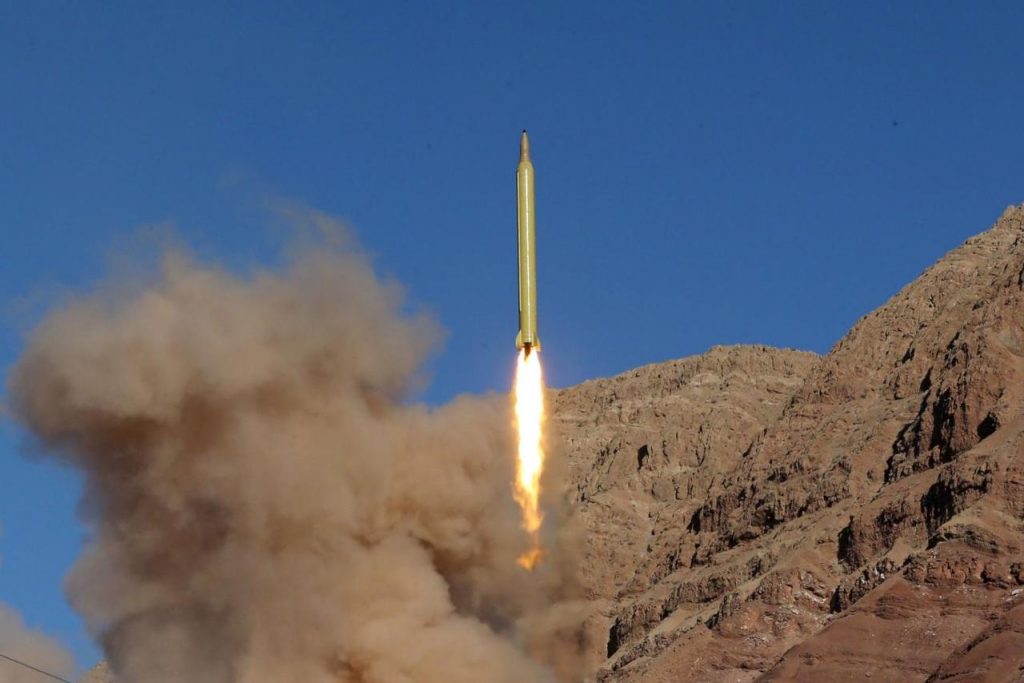
- ARAB NEWS
- 05 Jul 2025

The European powers appear to be changing their position toward the Islamic Republic, as they last week warnedthat Iran is developing nuclear-capable ballistic missiles. The UK, France and Germany (E3) — all signatories to the 2015 Joint Comprehensive Plan of Action (JCPOA) nuclear deal — stated in a letter to the UN that Iran had in April tested a Shahab-3 missile variant that is “equipped with a new maneuverable re-entry vehicle” and could deliver a nuclear weapon.
Tehran sees the potential change in the E3’s stance as a threat to its national security and the survival of the theocratic establishment. Foreign Minister Mohammed Javad Zarif lashed out, branding the letter a “desperate falsehood” designed by the European powers “to cover up their miserable incompetence in fulfilling (the) bare minimum of their own #JCPOA obligations.” However, Zarif failed to mention that Tehran is violatingUN Security Council resolution 2231, which calls on Iran not to “undertake any activity related to ballistic missiles designed to be capable of delivering nuclear weapons, including launches using such ballistic missile technology.”
The EU has been attempting to save the nuclear deal through a mechanism called the Instrument in Support of Trade Exchanges (Instex), which aims to help Iran and the European countries bypass US sanctions. But the Iranian regime is not totally satisfied due to the fact that its revenues and oil exports continue to decline despite the EU’s appeasement policies.
More fundamentally, Iran’s leaders claim that they ratcheted up their nuclear and missile activities due to the US’ withdrawal from the nuclear agreement. This claim is absurd because Tehran has a history of ballistic missile activity in violation of resolution 2231, even before President Donald Trump pulled his country out of the JCPOA.
After the nuclear deal was struck in 2015, the Iranian regime received huge additional revenues, which helped it further advance its ballistic missile program and test-fire more missiles. For example, soon after the deal was agreed, in October and November 2015, Iran testedthe precision Emad missile and the Ghadr-110. In March 2016, Iran test-fired several missiles, including the Qiam 1. In January and possibly September 2017, Iran tested the medium-range Khorramshahr ballistic missile. And, in June 2017, for the first time, Tehran launched ballistic missiles into another country — Syria — when six Qiam missiles were fired into Deir Ezzor province.
Hours after that June 2017 attack, the US office of the National Council of Resistance of Iran (NCRI) revealed that, on the orders of Supreme Leader Ali Khamenei, Tehran had accelerated its missile activities in the wake of the nuclear deal. Basedon detailed intelligence obtainedfrom inside the clerical establishment in Iran — specifically reports obtained from the Ministry of Defense and the Islamic Revolutionary Guard Corps (IRGC) — the NCRI showed Khamenei had tasked the IRGC’s Aerospace Force with executing this mandate.
The Iranian opposition group also revealed the locations of 42 centers involved in the production, testing and launching of missiles by the IRGC. Of these, 15 were part of the regime’s missile manufacturing network.
It is unrealistic to argue that Iran’s missile program is not connected with the regime’s nuclear program. For example, the missile center in Semnan has actively collaborated with the SPND, the organization reportedly tasked with building a nuclear bomb. SPND is the Persian acronym of the engineering unit for the nuclear weapons program inside the Iranian government, which is called the Organization of Defensive Innovation and Research. The NCRI first revealedthe existence of the SPND in 2011. Three years later, it was placed on the US State Department’s sanctions list.
Leaders across the Iranian political spectrum appear to be united in investing in the ballistic missile program because all factions realize the survival of their political establishment is at stake. President Hassan Rouhani has repeatedly emphasizedthat Iran’s missile activities will continue unabated. Soon after the nuclear deal was agreed, he famously statedthat “we will have a new ballistic missile test in the near future that will be a thorn in the eyes of our enemies.”
Leaders across the Iranian political spectrum appear to be united in investing in the ballistic missile program.
Dr. Majid Rafizadeh
The Iranian regime has also been smugglingits missiles to its proxies in other countries, including in Iraq and Yemen, as confirmed by the discovery of a “cache of weapons and advanced missile components” by the US Navy last week.
Even though France, Germany and the UK have expressed concern over Iran’s ballistic missile activities, the EU is yet to take concrete action to hold the Iranian regime accountable. This is due to the fact that the EU still wants to keep the nuclear deal alive and protect its economic and trade ties with Tehran, particularly in the energy sector.
The international community must enact and enforce effective and broad sanctions against Iran’s missile program and all its related entities, institutions and individuals. This includes designating the IRGC as a foreign terrorist organization and expelling it and its affiliated militias and proxies from other countries.